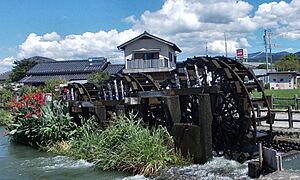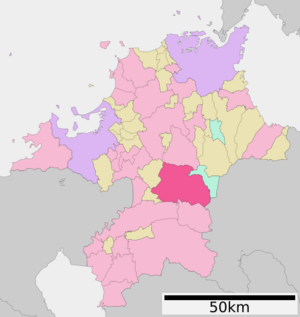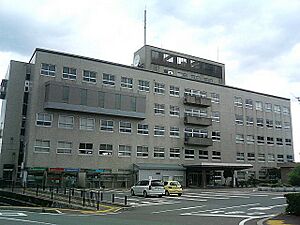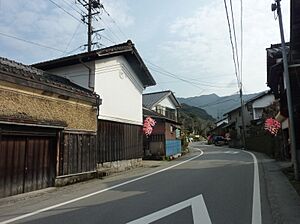Asakura, Fukuoka facts for kids
Quick facts for kids
Asakura
朝倉市
|
|||||||||||
|---|---|---|---|---|---|---|---|---|---|---|---|

Asakura Three Waterwheels
|
|||||||||||
|
|||||||||||
 |
|||||||||||
| Country | Japan | ||||||||||
| Region | Kyushu | ||||||||||
| Prefecture | Fukuoka | ||||||||||
| Area | |||||||||||
| • Total | 246.71 km2 (95.26 sq mi) | ||||||||||
| Population
(January 31, 2024)
|
|||||||||||
| • Total | 50,488 | ||||||||||
| • Density | 204.645/km2 (530.028/sq mi) | ||||||||||
| Time zone | UTC+09:00 (JST) | ||||||||||
| City hall address | 412-2 Bodaiji, Asakura-shi, Fukuoka-ken 838-0061 | ||||||||||
| Climate | Cfa | ||||||||||
|
|||||||||||
Asakura (朝倉市, Asakura-shi) is a city in the central part of Fukuoka Prefecture, Japan. As of January 2024, about 50,488 people live here. The city covers an area of 246.71 square kilometers.
Contents
Geography
Asakura is located in the middle of Fukuoka Prefecture. It is about 40 kilometers southeast of the city of Fukuoka. It is also about 20 kilometers northeast of Kurume.
Neighboring Cities and Towns
Asakura shares borders with several other places.
Weather in Asakura
Asakura has a humid subtropical climate. This means it has hot, humid summers and mild winters. The average temperature each year is about 15.9 degrees Celsius. July is usually the wettest month. The highest temperature ever recorded was 38.8 degrees Celsius in July 1994. The coldest was -8.3 degrees Celsius in January 2016.
| Climate data for Asakura (1991−2020 normals, extremes 1977−present) | |||||||||||||
|---|---|---|---|---|---|---|---|---|---|---|---|---|---|
| Month | Jan | Feb | Mar | Apr | May | Jun | Jul | Aug | Sep | Oct | Nov | Dec | Year |
| Record high °C (°F) | 19.8 (67.6) |
24.7 (76.5) |
26.1 (79.0) |
31.4 (88.5) |
35.1 (95.2) |
37.6 (99.7) |
38.8 (101.8) |
38.4 (101.1) |
38.2 (100.8) |
32.8 (91.0) |
26.8 (80.2) |
24.2 (75.6) |
38.8 (101.8) |
| Mean daily maximum °C (°F) | 9.8 (49.6) |
11.5 (52.7) |
15.3 (59.5) |
20.9 (69.6) |
25.8 (78.4) |
28.2 (82.8) |
31.8 (89.2) |
33.2 (91.8) |
29.4 (84.9) |
24.2 (75.6) |
18.1 (64.6) |
12.1 (53.8) |
21.7 (71.0) |
| Daily mean °C (°F) | 4.7 (40.5) |
6.0 (42.8) |
9.4 (48.9) |
14.4 (57.9) |
19.2 (66.6) |
22.9 (73.2) |
26.8 (80.2) |
27.4 (81.3) |
23.6 (74.5) |
17.9 (64.2) |
12.1 (53.8) |
6.7 (44.1) |
15.9 (60.7) |
| Mean daily minimum °C (°F) | 0.3 (32.5) |
0.9 (33.6) |
3.9 (39.0) |
8.4 (47.1) |
13.4 (56.1) |
18.6 (65.5) |
23.0 (73.4) |
23.3 (73.9) |
19.3 (66.7) |
12.8 (55.0) |
6.9 (44.4) |
2.0 (35.6) |
11.1 (51.9) |
| Record low °C (°F) | −8.3 (17.1) |
−7.5 (18.5) |
−5.6 (21.9) |
−1.6 (29.1) |
3.2 (37.8) |
8.6 (47.5) |
14.1 (57.4) |
15.1 (59.2) |
6.2 (43.2) |
0.7 (33.3) |
−2.0 (28.4) |
−5.7 (21.7) |
−8.3 (17.1) |
| Average precipitation mm (inches) | 64.6 (2.54) |
81.4 (3.20) |
121.8 (4.80) |
139.2 (5.48) |
169.5 (6.67) |
333.6 (13.13) |
413.2 (16.27) |
206.9 (8.15) |
176.6 (6.95) |
92.4 (3.64) |
88.9 (3.50) |
65.0 (2.56) |
1,953 (76.89) |
| Average precipitation days (≥ 1.0 mm) | 9.0 | 9.1 | 10.9 | 10.1 | 9.0 | 13.3 | 12.9 | 10.6 | 9.5 | 7.0 | 8.5 | 8.6 | 118.5 |
| Mean monthly sunshine hours | 112.5 | 129.7 | 162.3 | 181.5 | 194.6 | 122.6 | 164.1 | 194.7 | 159.6 | 175.3 | 139.1 | 118.9 | 1,854.9 |
| Source: Japan Meteorological Agency | |||||||||||||
Population Changes
The population of Asakura has changed over many years. In 2020, about 50,273 people lived in the city. The city has been counting its population since 1920.
| Historical population | ||||||||||||||||||||||||||||||||||||||||||||||||||||||||||||||||||||||
|---|---|---|---|---|---|---|---|---|---|---|---|---|---|---|---|---|---|---|---|---|---|---|---|---|---|---|---|---|---|---|---|---|---|---|---|---|---|---|---|---|---|---|---|---|---|---|---|---|---|---|---|---|---|---|---|---|---|---|---|---|---|---|---|---|---|---|---|---|---|---|
|
|
|||||||||||||||||||||||||||||||||||||||||||||||||||||||||||||||||||||
| Asakura population statistics | ||||||||||||||||||||||||||||||||||||||||||||||||||||||||||||||||||||||
History of Asakura
The area where Asakura is now located has a very long history. It was part of an old Japanese province called Chikuzen. Some people think it might have been the location of an ancient kingdom called Yamatai.
In 661 AD, an empress named Saimei moved Japan's capital here. This was to prepare for a possible battle with other countries. However, she passed away that same year, and the battle did not happen.
Later, in 1203, a family named Akizuki started building Akizuki Castle. This family ruled the area for many generations. In 1876, some former warriors tried to change the government. This event is known as the Akizuki Rebellion.
How Asakura City Was Formed
Over time, many smaller towns and villages joined together to form the city of Asakura.
- In 1889, the town of Amagi and 18 villages were created.
- Akizuki became a town in 1893.
- In 1954, many towns and villages merged to create Amagi City.
- Asakura became a town in 1962.
- Finally, on March 20, 2006, Amagi, Asakura, and Haki merged. This created the modern city of Asakura we know today.
Economy
Asakura is an important business center for its region. Big companies like Bridgestone (known for tires) and Kirin Beer have large factories here. However, farming is the most important part of the local economy.
Education
Asakura has many schools for young people. The city government runs 11 elementary schools and six junior high schools. The Fukuoka Prefecture also operates three public high schools.
High Schools
- Asakura Kōyō Senior High School
- Asakura Higashi Senior High School
- Asakura Senior High School
Junior High Schools
- Amagi Junior High School
- Akizuki Junior High School
- Haki Junior High School
- Hiramatsu Junior High School
- Jūmonji Junior High School
- Nanryō Junior High School
Elementary Schools
- Amagi Elementary School
- Asakura Higashi Elementary School
- Akizuki Elementary School
- Daifuku Elementary School
- Fukuda Elementary School
- Haki Elementary School
- Hinashiro Elementary School
- Kanagawa Elementary School
- Mada Elementary School
- Minagi Elementary School
- Tateishi Elementary School
Transportation
You can travel to and from Asakura by train and car.
Train Lines
- Amagi
![]() Nishi-Nippon Railroad Amagi Line
Nishi-Nippon Railroad Amagi Line
- Amagi - Mada - Kamiura
Highways
 Ōita Expressway
Ōita Expressway National Route 322
National Route 322 National Route 386
National Route 386 National Route 500
National Route 500
Fun Places to Visit
Asakura has many interesting places to explore!
- Akizuki Historical Preservation District: This area has old buildings and streets that show what Japan was like in the past.
- Akizuki Castle Ruins: You can visit the remains of the old Akizuki Castle.
- Horikawa Canal and Asakura Water Wheels: See the famous old water wheels that were used for farming.
- Eso Hachiman Shrine: A beautiful traditional Japanese shrine.
- Hagi Kōgoishi: Ancient ruins that are part of Japan's history.
- Hiratsuka Kawazoe Site: Another historical site with old remains.
- Oda Chausutsuka Kofun: An ancient burial mound.
Local Celebrations
Asakura also has special events and festivals.
- Dorouchi Festival
- Oshiroi Festival
Famous People from Asakura
- Michiko Kichise: A well-known actress and model.
- Suu Minazuki: A talented manga artist.
See also
 In Spanish: Asakura (Fukuoka) para niños
In Spanish: Asakura (Fukuoka) para niños






